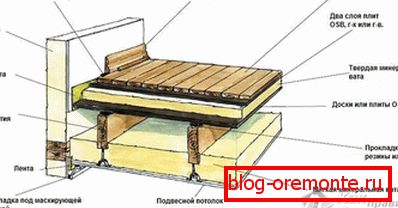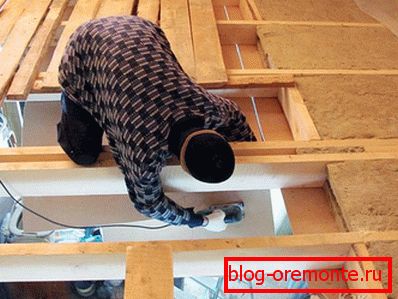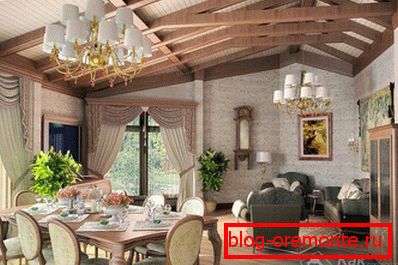How to make a hardwood floor
In this article we will acquaint you with how to make a wooden ceiling on the ceiling beams with your own hands, and also tell you about the general procedure for holding events of this type.
Immediately, we note that the wooden beams over the beams are used, as a rule, only in private suburban housing construction and are settled either between floors or between a room and an attic. This type of floor has several advantages not only in comparison with standard reinforced concrete blocks, but also in relation to monolithic type floors.

These benefits are as follows:
- wooden floors are easily erected and do not require any additional technical means (a crane, for example, or special concreting technology) for their construction;
- they are much lighter than their counterparts, made from famous building materials;
- when using such overlappings the base of a structure can be slightly facilitated.

In addition, it should be noted the relatively low cost and high speed of installation of this structural element. The disadvantages of overlapping of this class can be attributed only to their high fire risk and the possibility of destruction by the bark beetle. In addition, they are characterized by lower sound insulation than concrete structures, they are sensitive to changes in temperature and humidity of the surrounding air.
True, you can always eliminate these drawbacks if you apply special impregnations that significantly reduce these risks.
Main characteristics of joists

For the manufacture of floor beams used conventional solid wood. With the same success, more durable glued samples are used, the length of which is allowed to increase to 15 meters. The material from which the beams are made can be both softwood and hardwood. The distance between adjacent beams should not exceed one meter. Beams with a length of 2.5–4 meters (with a ratio of height to width of their cross section - 1.4: 1) are considered to be the most optimal for spans of typical residential buildings.
The choice of beam section in the most general case is determined by the load on which this overlap should be calculated. In order to increase the bearing capacity of such structures, beams are placed, as a rule, along a short wall.

As an option for the design of such beams can be considered the case when they are just sheathed with boards from the upper side. The lower parts of the beams, open to public viewing, contribute to the creation of a certain style in the design of a given room. If desired, you can also sheathe them and make a typical suspended ceiling.
The correct solution to the basic question “how to make a wooden floor correctly?” Also includes a limitation regarding the maximum length of the beams.
The length of the floor beam between residential floors should not exceed 5 meters, while for the floors between the residential floor and the attic, this figure can reach 6 meters.
Ceiling installation

Installation of floor beams is usually done in the following order:
- Before laying the finished beam in the wall niche, its ends are wrapped with two layers of roofing material, and the length of the waterproofing layer is selected with a margin (but not less than 25 cm). After that, it starts up the wall and fits there so that the inner edge of the roofing material protrudes 2-3 cm.
- Immediately after installing the beam into the slot designed for it, it is fixed in place with a special anchor bolt.

- Next, we turn to the insulation of the ceiling, for which you can choose the usual mineral wool or natural material similar to it (sawdust, seaweed, etc.). Polystyrene is not recommended for these purposes, as this material does not allow air to pass through. You can use for warming and conventional claydite, but it is necessary to take into account the fact that the latter gives an increased load on all elements of the constructed structure.
- Laying (backfilling) of the insulation is done immediately after you have closed the beams from the bottom side with the finishing material of your chosen type. From above, the flooring is usually made of planed tongue-and-groove boards, which is also the floor for the upper floor.
- After you have laid voids with insulation, you will need to worry about waterproofing the floor itself. To do this, you will need a waterproofing film, which will need to be laid and fixed on top of the insulation.

- After closing this whole structure with a finished floor, your ceiling will be completely ready.
Video
From the following video you will learn how professionals put overlaps and calculate the number and size of beams for interfloor overlap: